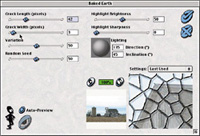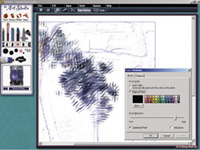Software Roundup Part II
New And Improved Tools For Producing Artistic Photographs
Ever since the Pictorialist movement at the turn of the 20th century, photographers have always enjoyed applying what many have dubbed "painterly" effects to their images. Pixographers are no strangers to this desire to create artistic effects from digital images by using image-enhancement software as well as different kinds of papers for output on ink jet printers. Before making any kind of image manipulations, you should consider the selection of the original photograph itself. It helps if the photograph has a strong sense of composition. To me, simpler images seem to work better than more complex ones. I also feel your best photographs should have little enhancement beyond the kind of burning, dodging, and dust spotting you would apply in a traditional darkroom. For these kinds of images I do little manipulation, except for cropping extraneous details from the edges. But that's just my opinion. In digital imaging, like everything else in photography, exploration is the name of the game. If you prefer to crop your photographs so tight that each pixel is the size of a boulder and enhance them so little remains from the original image, who cares as long as you're happy with the final result. |
|||
Here's a personal look at some of the tips, tools, and techniques I've been using to paint with pixels. Keep in mind that these are not the only ones available; there are others that I may not know about or haven't tried or that may be introduced after this article goes to press. Give them all a try. Consider what follows only as a suggestion; a way to get started with your own explorations. Outside The Box Professor Franklin's Instant Photo Artist is for pixographers who prefer an artistic approach to manipulating photographs. This Windows-based program's Art Studio module lets you turn photographs into images that retain the content of the original image while adding that "painterly" look. The under-$40 program can acquire digital images from a CD-ROM (including Photo CD), your hard drive, and from a scanner, digital camera, or any TWAIN device. Art Studio begins by opening an outline of your photograph, and then you select specific tools to apply the artistic touch to that outline. Some of the tools include paintbrushes, crayons, pencils, airbrushes, and markers, all of which work like the real thing. You can also select from styles, such as Monet, Van Gogh, Acrylic, Mosaic, Watercolor, and others. You can apply any of the tools using a mouse, but a graphics tablet--even one of those tiny 4x5 models--is recommended for controlling the program's subtleties. A Design Studio module lets you take these artistic creations and, using built-in templates, produce greeting cards, newsletters, labels, calendars, post cards, and other desktop publishing projects. ArcSoft's PhotoMontage is one of the truly original graphics products to come along in a long time. |
|||
Starting with any image, PhotoMontage lets you turn it into a montage composed of thousands of tiny microphotographs. No hard disk space is gobbled up since PhotoMontage pulls the little photos off of a CD-ROM disc. The package includes a library of 200,000 tiny images that can be personalized by adding 100 of your own photos to its database. ArcSoft offers additional libraries covering specific topics such as sports, nature, and animals. Images can be acquired directly from a scanner, digital camera, or loaded from a file, including Kodak's Photo CD. PhotoMontage lets you tweak the acquired image by cropping and adjusting brightness and contrast. I found the best montages were created from photographs that were slightly brighter and contrastier than what might be considered "normal." The interface and all of the program's controls are so intuitive I never even looked at the User's Guide to figure out what to do next. After the image looks the way you want, the program turns it into a negative then converts it into a montage--which is a fascinating process to watch. You can save your finished montage in all popular graphic file formats. For super-sized posters, the company offers a direct link to printing services on their web site. PhotoMontage is available for both Mac OS and Windows computers for $29. Synthetik's Studio Artist 1.5 is a Mac OS-only program that's designed for working with digital video as well as still images. With only a brief review of the Tutorial Guide, you'll be able to create dramatic-looking graphic effects faster and better than you could possibly imagine. The interface is quite different from any other program, so you'll need to spend some time exploring the program's immense capabilities. All this is helped with 1000 presets that let you just click and go. The slider controls provided for each of these presets provide an endless amount of variation in ways to "play" with digital images. Studio Artist has effects ranging from painterly to one called "Comic Book" and embraces many artistic styles and disciplines. There is even a real-time warping feature that Adobe only recently added to Photoshop. There also are many vector-based video effects that users of DV software and hardware will use to add interesting Hollywood touches to their productions. Studio Artist may be the most fun you've ever had with graphics software. The program itself requires 96MB of memory, so if you have yet to pump some inexpensive RAM into your machine, now's the time to do so. If you're new to Windows-based image enhancement programs, Jasc's Paint Shop Pro is one of the best places to start. The current version, Paint Shop Pro 7.02 features the now-familiar interface featuring a horizontal tool bar augmented by another vertical one, located on the left-hand edge of the screen. A color palette, which can be toggled off and on, rests snugly on the right-hand edge along with slide-out menus for Styles, Textures, and Lock. As part of the interface design, Jasc uses groups of floating palettes that are visible only by their headers and expand when your cursor approaches them. Export Wizards let web newbies create transparent GIF or JPEG files and "before and after" windows that let you see the results of your choices before saving. Animation capabilities are available with the bundled Animation Pro 3 software. |
|||
Paint Shop Pro 7.02's other features include multiple color gradients, a seemingly endless array of special effects tools and filters, color layers, and a Print Multiple Image command that offers a touch of desktop publishing. Text capabilities are impressive and function in a logical manner. Although Jasc doesn't necessarily look at it as such, I've always treated Paint Shop Pro as a graphics file conversion program. The latest version features expanded file format support, allowing you to save and read files in formats as widely diverse as Amiga, Macintosh PICT, and MacPaint. With a download price under $100, Paint Shop Pro 7.02 is one of the best ways I've found to get acquainted with the art of image manipulation. Paint Shop Pro has been around for some time and each new version gets better and better. If only they offered a Mac OS version€ This is just a brief introduction to the almost unlimited number of ways you can create artistic effects with your original photographs. But it's not the only way. Rather, it represents just a few of the tools and techniques I play with when working with my own images to create what I feel are interesting effects. Others might use different techniques and different software. Viva la difference. |
|||
Inside Adobe Photoshop When you choose any one of these effects, a dialog box appears that lets you control how the various aspects of the filter are applied. Don't be timid when making these judgments; move the sliders to the extreme ends of each scale and watch what happens. A preview window will show a portion of the image. Click on it and drag the selection rectangle around so a critical part of your image appears in the small window. Use the plus and minus buttons to zoom in and out of the scene to see how all those slider gymnastics look up close and personal. When you click OK, all is not lost. If you went overboard on the filter, use the Edit>Fade command to diminish the effect until you get something you might like better. |
|||
Don't overlook Photoshop Actions, which are short scripts that trigger a sequence of image-editing steps. You'll find Actions by choosing Windows>Show Actions, but I prefer to drag the Actions palette onto Photoshop 6's "dock" at the top of the screen so it's available at all times. Although Actions apply artistic effects, they are not filters and don't have to be treated as such. Clicking on the top of the Actions palette and selecting Load Actions installs Actions, which are completely cross-platform and use an .ATN file type. One of Actions' main attractions is that they're easy to use. A single click is all it takes to apply artistic effects. You can customize Actions based on how you use them. You can create your own Actions, but some are provided by Adobe on their Photoshop CD-ROM in the "Goodies" folder. Some Actions, such as nik Efex, are available commercially, but you can also find Actions on the web at sites such as www.actionxchange.com The next step inside Photoshop is using third-party filter plug-ins instead of those that are built-in. Photoshop's open architecture lets it accommodate small software applications--called plug-ins--that customize the program to fit whatever kind of project you're working on. Adobe defined the standard, but compatible plug-ins can be used with other programs including Ulead Systems' PhotoImpact, Corel's Painter and PHOTO-PAINT, and MicroFrontier's Color-It!, Enhance, and Digital Darkroom. Plug-ins are installed using either the installer provided or by clicking and dragging them into Photoshop's "Plug-ins" folder. There are many different filters inside that folder, but except for general housekeeping, it really doesn't matter where you place your new plug-ins as long as they're inside the Plug-ins folder. Inside Photoshop, third-party filter plug-ins can be accessed through its Filter menu. |
|||
Manufacturers/Distributors |
|||
(800) 278-4478 fax: (800) 275-3380 www.legionpaper.com Streetwise Software, Inc. (800) 743-6765 fax: (310) 828-8258 www.swsoftware.com Synthetik Software, Inc. (415) 864-6582 fax: (415) 864-0433 www.synthetik.com The TECHnik (619) 562-4456 fax: (619) 562-5583 www.tech-nik.com Xaos Tools, Inc. (510) 525-5465s www.xaostools.com |








































